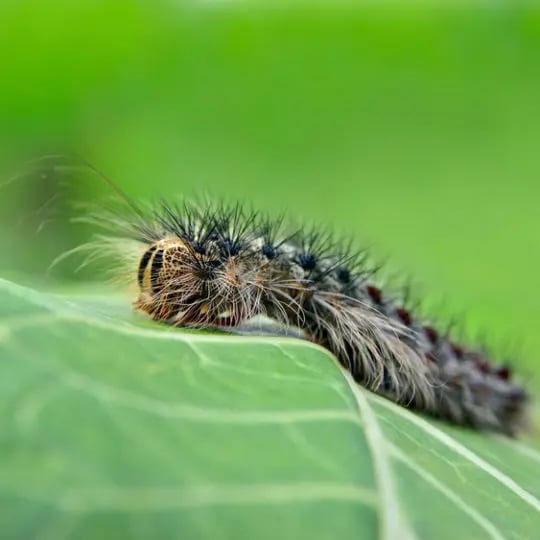Tree Insects: How to Identify and Eliminate Six of the Deadliest

Spiders, swallowtail butterflies, praying mantises, and honeybees are some of the most beneficial bugs for our backyards. But other tree insects contribute to major health problems and even death for our trees. Here’s a list of the six deadliest bugs, by category, for trees in our region of the country. We’ve also got tips on how to eliminate each of these nefarious tree insects.
1. Aphids
What they are: Aphids are tiny, pear-shaped, soft-bodied insects. They suck the fluid from your tree’s leaves and cause severe damage. Their bodies can be yellow, brown, green, red or black. Look for two slender, horn-shaped protrusions on the bug’s posterior to be sure. Another telltale sign: your tree’s leaves dripping sap. How to eliminate them: You’ll probably need both cultural and chemical methods to completely get rid of them. Try wiping or spraying affected leaves with water mixed with dish soap. Insecticidal sprays are also worth a try, but read the label carefully to apply correctly.
2. Beetles
What they are: Beetles represent a huge portion of the animal kingdom. If all animals were lined up, every fourth one would be a beetle of some kind. They can be identified by their antennae and pair of durable front wings. In the Eastern U.S., some of the worst beetles for trees are the Asian Longhorn, Black Turpentine, Ips, and Bark Beetles. Weevils such as the Pales Weevil, also in the beetle family, are highly destructive. How to eliminate them: Beetles bore into weakened wood, so prevent infestations by keeping your tree healthy. If the buggers are already present, an insecticide can work. However, it must be applied before they burrow into the tree, lay eggs, and let their larvae feast on the roots. Contact the experts at Green Pest Solutions to get rid of an existing infestation properly and safely.
3. Adelgids
What they are: Similar to aphids, adelgids are small, wingless insects that love to suck the sap from trees. In our region, the Balsam Woolly and Hemlock Woolly adelgids are deadly to fir, hemlock and spruce. Both are invasive species with no natural predators. They live within white, cottony sacs along infested branches. How to eliminate them: As with aphids, you can spray affected needles and branches with a solution of water and dish soap. Try an insecticidal spray if you can time it right. They work best when the nymphs have just hatched and are crawling (usually around March). For more rigorous and thorough treatments such as soil drenches, soil injections and trunk injections of insecticide, contact a reputable exterminator.
4. Moths and Moth Larvae (Caterpillars)
What they are: Certainly not all caterpillars and moths are deadly for trees in our area. Some are lovely, harmless, and deserve protection. But the Eastern Tent caterpillar, and Gypsy, Codling, and Nantucket Pine Tip moths pose a real threat, especially when their populations soar. They feed on leaves and can leave trees totally defoliated. How to eliminate them: Hand-pick and crush offending caterpillars. Remove egg masses, such as those made by tent caterpillars, and drop into soapy water. Identify affected foliage and apply bacillus thuringiensis, a chemical that kills only caterpillars. Finally, invite birds, a natural predator of caterpillars and moths natural predator, to your yard.
5. Borer
What they are: Wood-boring insects such as the Eastern Pineshoot, Emerald Ash, and Shade Tree borers will drill holes into your trees, chew the insides, and let their babies dine on the living tissue. They belong to several categories of insect (Emerald Ash is a beetle, for example) and are best identified by the tiny holes they leave in trunks, bark and branches. How to eliminate them: Keep your trees healthy so they are less vulnerable to attack. If adults are already present, and it seems possible to isolate them and prune a branch without removing the entire tree, do so. Systemic insecticides are also an option, but usually to prevent recurrence. For best results, contact a professional pest service company such as Green Pest Solutions to discuss treatment options for your borer problem.
6. Scale insects
What they are: Scale insects comprise thousands of species of odd-shaped, immobile insects that resemble tiny shells or waxy bumps. They feed on sap from the tree’s vascular system. Because of their size and permanent attachment to the plant that they parasitize, they can go unnoticed until they have inflicted serious damage. How to eliminate them: Use a dull knife or old toothbrush to scrape off small infestations. Prune off more heavily affected branches and twigs. You also can try spraying a horticultural oil product on trees with large populations of these insects, but you have to time the treatment to coincide with egg hatching (usually around May).
Call Green Pest Solutions to Eliminate Deadly Tree Insects
If you suspect an infestation with one of these dangerous tree insects, contact Green Pest Solutions right away. Our staff has more than 100 years combined experience. Our pest specialists and technicians have years of experience in the pest control industry. We would be happy to help come up with a solution and treatment program that is right for you and your trees’ needs. Call our team at Green Pest Solutions today at 855-312-7157.